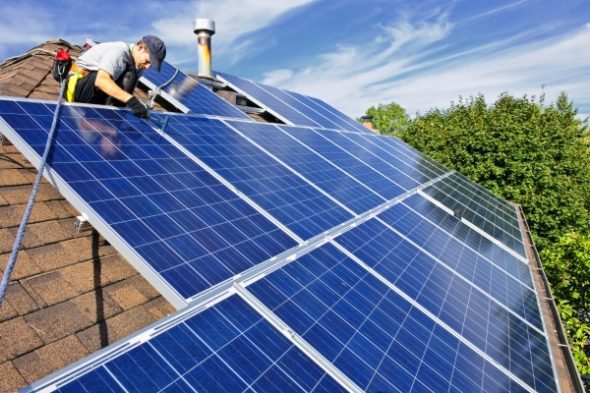The Australian rooftop solar PV industry may have to prepare for a future with no federal government incentives. There is growing speculation that the small scale renewable certificate may be cut in a revamp of the national renewable energy target.
RenewEconomy understands that there is a renewed push by utilities and generators – particularly but not exclusively the state-owned ones – to close the small scale renewable energy scheme (SRES) and cease issuing renewable energy certificates for rooftop solar. Others suggest cutting the price cap on the certificates.
The renewable energy target is already under threat from utilities and generators, state governments, and sympathizers within the Abbott ministry to either remove, or severely dilute, the 20 per cent target.
Large scale developers are more or less resigned to having the fixed target of 41,000GWh for the large scale component moved beyond 2020 – possibly to 2022 or 2025. Because of falling demand, the government will claim that renewables will still account for 20 per cent of national demand in 2020.
However, less expected is a new attack on the small scale solar subsidy. However, Australia already has more than 3,000MW of rooftop solar, is adding around 700-800MW a year, and this is having a big impact on the returns of generators such as Stanwell Corp, and the business models of network operators.
Australian utilities are not alone, because rooftop solar is threatening their business models across the world – particularly in north America and Europe. Consider these remarkable comments made this week by Mark Ferron, one of the heads of the California Public Utilities Commission, who resigned this week.
He noted that utilities, while claiming to like solar, “would still dearly like to strangle rooftop solar if they could.” Ferron said the CPUC – and by inference other regulators – would come under pressure to “protect the interest of the utilities over those of consumers and potential self-generators, all in the name of addressing exaggerated concerns about grid stability, cost and fairness.”
That is exactly what has been happening in Australia, where solar is couched in terms of the “death spiral” and its potential impact on non-solar users, rather than the benefits it can bring to consumers and the grid as a whole, as the heatwave underlined last week.
The RET once offered 5 certificates for each estimated megawatt hour of electricity produced by rooftop solar. This – in combination of generous state-based feed-in-tariffs – created a flood of certificates and forced authorities to separate the small scale scheme to absorb the excess. The multiple was rapidly brought down to one as it became clear that the cost of rooftop solar PV had fallen.
Ironically, that small scale solar market had finally reached balance just as the utilities make a new push to have it removed altogether. Their argument is that rooftop solar no longer needs the subsidy (the states have already largely removed feed in tariffs). The Queensland government, for instance, is constantly deflecting the blame on rising electricity bills on to the cost of solar subsidies.
The reality is that the small scale scheme adds very little to electricity bills, less than one per cent, according to official data, and the Climate Change Authority, which reviewed the RET in 2012.
However, the CCA raised the possibility that the certificate multiple could be reduced below one (say to 0.5/MWh) if the costs of the scheme rose beyond 1.5 per cent of consumer bills, and the payback of rooftop solar PV fell below 10 years.
That assessment brought howls of protest from the solar industry, which pointed out that few businesses would invest in technology on such a payback, so why should households.
The reality is, however, is that the payback for rooftop solar PV has now fallen to below 5 years, and to 7 years for commercial installations. The solar industry says that removing the certificates would add two years to that payback.
That would make rooftop solar less obtainable and attractive for those on lower incomes. However, the government has the potential to offset this by targeting, as it has flagged, its “one million solar roofs” program to the lower income, rental and apartment markets. That program has already slashed its proposed subsidy from $1,000 to $500 a system, but it is not yet clear how it would be introduced.
There have been arguments that it is superfluous if the RECs exist. Others such as ARENA are working on financing models for lower income and rental households, arguing that this would be a more effective system.
In a recent submission to the Direct Action proposal, Origin Energy, the largest utility in Australia, stopped short of calling for the SRES to be scrapped, but called for the $40 cap on the price of small scale certificates to be reduced. It also questioned the one million rooftop program, noting that on its estimates, another million roofs would be connected to solar by 2020 anyway.
“It is against this policy context that Origin believes that current support for solar PV systems should be moderated,” it writes in its Senate submission. It also wants a 10kW limit on SRECs, which it noted had been proposed by the CCA. Any bigger system would still qualify for large scale renewable energy certificates, which are based on actual output rather than an upfront rated capacity.
The Federal Government has yet to release the terms of reference for its RET review, despite having committed to do so by early December. Part of the problem is the complication of the CCA remaining in existence after Labor and the Greens voted down its repeal.
However, removing the SRES could have implications for large scale developments, and it is not clear how the various targets would be resolved. No doubt the utilities will make clear their ideas when the RET review is finally open to submissions.








